Honoring Queen Sirikit’s legacy in Thai fashion and culture. Discover how her vision of craftsmanship, sustainability, and compassion continues to inspire global brands today.
Her Majesty Queen Sirikit, the Queen Mother of Thailand, passed away on October 24, 2025, at the age of 93. She devoted her life to the welfare of the Thai people, championing healthcare, education, and rural development initiatives that transformed countless lives. Beyond her royal duties, Queen Sirikit was a cultural ambassador and a strategic fashion icon, understanding that attire communicates dignity, respect, and identity.
Her keen fashion sense was inseparable from her mission. By carefully selecting garments that celebrated Thai silk heritage, she elevated national pride, fostered international cultural appreciation, and supported rural communities.
We extend our deepest condolences to the Royal Family and the people of Thailand. Her Majesty’s legacy of service, elegance, and cultural preservation will endure for generations.
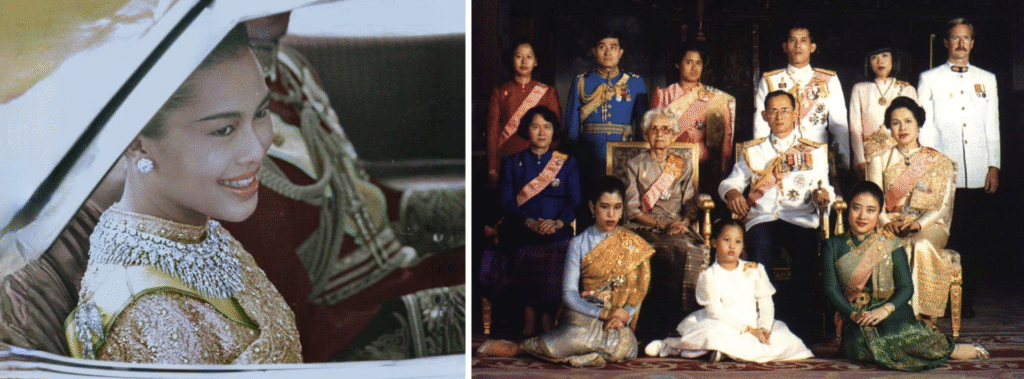
Her Majesty’s Enduring Contributions: A Historical Timeline
Queen Sirikit’s legacy extends far beyond her elegance and grace. Each milestone in her public life reflects her deep commitment to culture, community, and sustainability — values that continue to shape Thailand’s identity and inspire generations today.
1960s – The Spark of Revival
In the 1960s, Queen Sirikit observed the exquisite mudmee silk skirts of rural artisans and recognized both their beauty and the economic potential of supporting local weaving. She spearheaded initiatives to preserve traditional techniques, culminating in the creation of the Foundation for the Promotion of Supplementary Occupations and Related Techniques (SUPPORT Foundation) in 1976.
Through the foundation, she provided training, resources, and global exposure for rural artisans, ensuring that silk weaving, jewelry-making, painting, and other crafts could provide sustainable livelihoods while preserving centuries-old traditions.
Her collaboration with French couturier Pierre Balmain further amplified Thai silk’s reach. Balmain incorporated handwoven Thai silks from the SUPPORT Foundation into Queen Sirikit’s wardrobe for state visits and international engagements. This fusion of Western couture with traditional Thai fabrics showcased Thailand’s cultural sophistication and positioned Thai silk as a global luxury textile.
Additionally, the Queen Sirikit Museum of Textiles within the Grand Palace preserves her extensive collection of royal garments and textiles, celebrating her vision and serving as a cultural landmark and educational resource.
1970 – A Turning Point for Thai Silk
During a royal visit to the Northeast, Her Majesty admired the intricate mud-mee skirts worn by rural women and asked if they could weave one for her — a simple gesture that became a defining moment for the Thai silk revival.
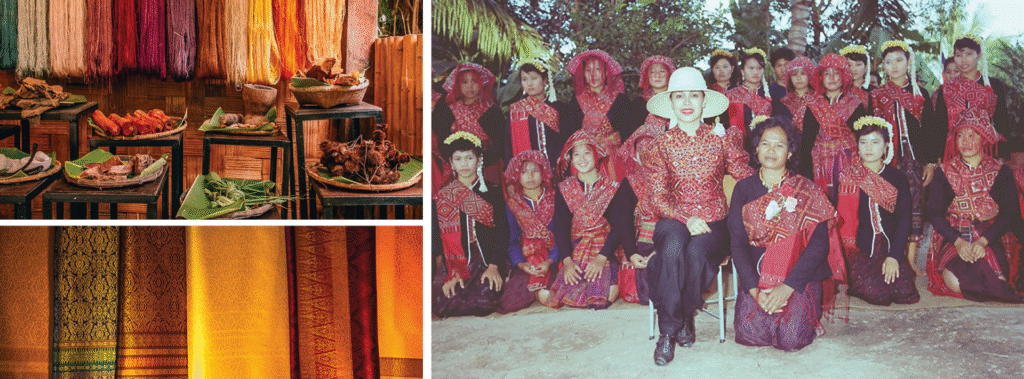
1976 – Founding of the SUPPORT Foundation
Her Majesty formally established the Foundation for the Promotion of Supplementary Occupations and Related Techniques (SUPPORT Foundation) under royal patronage to restore, promote, and develop traditional Thai handicrafts. The initiative provided villagers with sustainable income through skills training in weaving, jewelry-making, embroidery, and traditional art forms.
1980s–Present – Expanding Opportunity Nationwide
The SUPPORT Foundation has since grown into a national institution, with training centers in 50 provinces and more than 300,000 people engaged in traditional craftwork — from silk weaving and silverwork to khon mask making and basketry. These programs safeguard cultural heritage while improving rural livelihoods.
Creation of Thai National Dress
Recognizing the importance of national identity in modern diplomacy, Her Majesty commissioned the design of the modern Thai National Dress — a collection that includes styles such as Thai Ruan Ton, Thai Chitralada, Thai Amarin, Thai Chakri, Thai Boromphiman, and later Thai Dusit and Thai Prayuk. These ensembles united tradition with contemporary elegance, offering Thai women — and the world — a graceful vision of national attire.
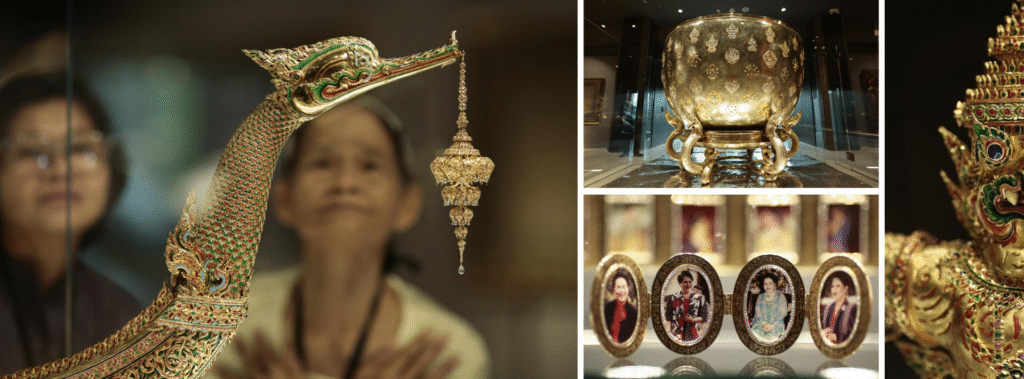
1991 – Environmental and Community Development Projects
Beyond textiles and fashion, Queen Sirikit’s compassion extended to rural welfare and environmental stewardship. Projects like “Small House in the Big Forest” promoted sustainable living within forest communities, integrating conservation, housing, and education. Her vocational programs also supported hill-tribe children, refugees, and marginalized groups, reinforcing her vision of inclusive national development.
A Lifelong Journey with the Thai People
Throughout her reign, Her Majesty accompanied King Bhumibol Adulyadej on countless visits to remote areas, listening to local communities and witnessing both their hardship and their artistry. Through these journeys, she made traditional crafts and silk weaving a cornerstone of Thailand’s strategy for rural empowerment and cultural preservation.
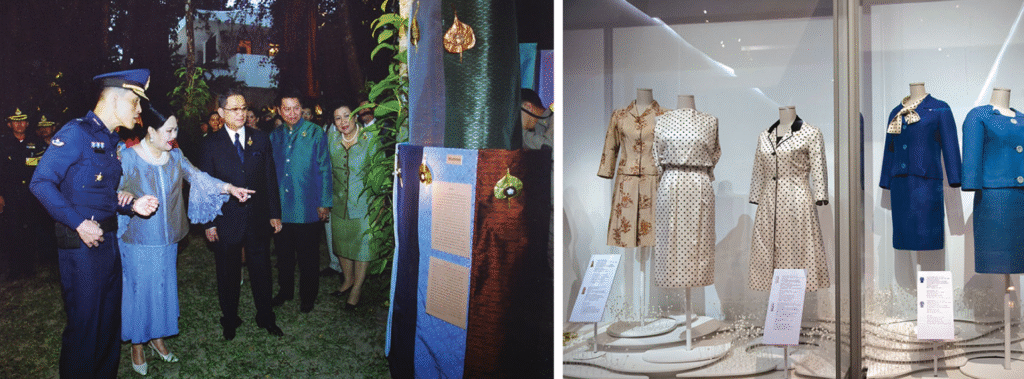
Timeless Wisdom from Queen Sirikit’s Style and Vision
Queen Sirikit’s fashion choices were never only about elegance—they conveyed cultural pride, diplomacy, and social responsibility. Her dedication to Thai silk and traditional crafts preserved centuries-old techniques while empowering artisans, ensuring that handmade work was valued and respected. Her life offers enduring lessons that resonate with anyone committed to cultural integrity and sustainability in creative work:
- Fashion as Cultural Storytelling
Every ensemble Queen Sirikit wore communicated identity, respect, and heritage. We learn that thoughtfully designed garments can carry meaning beyond aesthetics, serving as instruments of diplomacy and cultural connection. - Timeless Elegance and Quality
Clean lines, refined fabrics, and subtle embellishments defined her style. Her example reminds us that investing in quality and timeless design—rather than chasing fleeting trends—leaves a lasting impact. - Empowering Artisans and Preserving Craft
Queen Sirikit championed rural weavers and traditional crafts, turning handmade textiles into symbols of national pride. This teaches us the importance of respecting the artisans behind every creation, valuing their labor, and ensuring sustainable livelihoods. - Sustainability Through Tradition
By reviving Thai silk and local weaving techniques, she demonstrated that cultural preservation and environmental mindfulness can go hand in hand. At Deepwear, working closely with Thailand’s artisan communities has reinforced the principle that authentic, locally sourced, handcrafted materials are essential to responsible production. - Meaningful Investment in Craft
Her advocacy showed that paying a premium for exquisite handmade work is not indulgence—it is recognition of the skill, time, and heritage embedded in each piece. This principle remains central to how we approach sourcing and product development today.
Queen Sirikit’s legacy shows that true elegance is inseparable from compassion and cultural respect. Her influence endures in every artisan’s craft and every designer’s effort to create with purpose, reminding us that beauty is most powerful when it preserves and uplifts tradition.
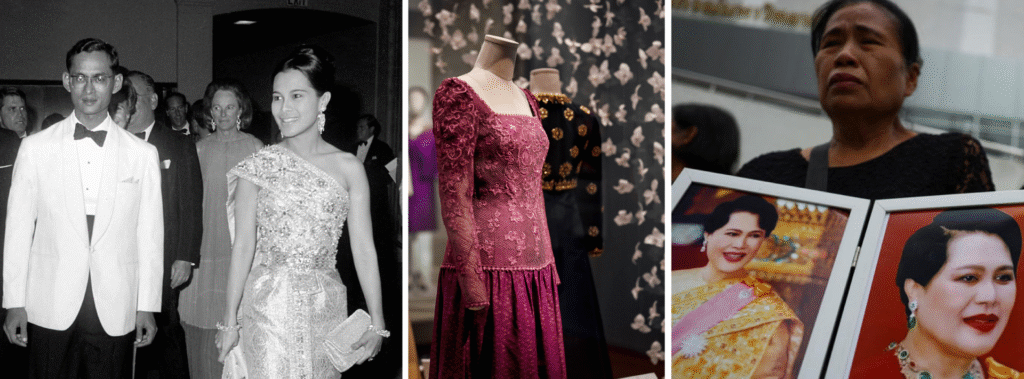
Honoring a Legacy
Her Majesty Queen Sirikit’s life reminds us that elegance, leadership, and cultural responsibility can be intertwined. Her strategic use of fashion amplified Thailand’s heritage, empowered communities, and strengthened national identity on the global stage.
At Deepwear, we join the people of Thailand in honoring Her Majesty Queen Sirikit’s lifelong devotion to culture, craftsmanship, and compassion. Her influence reminds us that fashion’s truest purpose lies not in profit, but in preserving beauty, uplifting people, and sustaining tradition for generations to come.